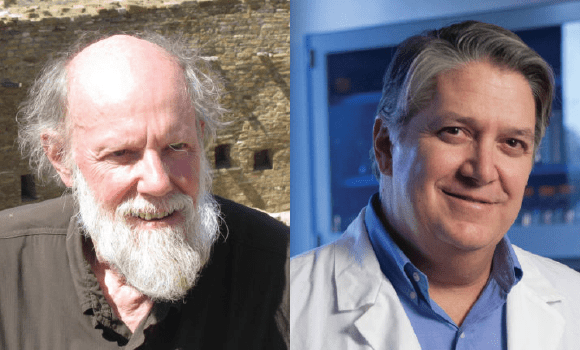
Progress with a Blood Test for Alzheimer’s Disease
A diagnostic test with 94% accuracy of predicting Alzheimer’s disease, using age and genetic risk factors data, has been developed by three members of the Cure Alzheimer’s Fund Research Leadership Group.
The test relies on measuring the presence of a sticky, aggregated protein called amyloid-β in the blood. The researchers hypothesized that if there was a lot of amyloid-β accumulating in the brain, there would be less amyloid-β circulating and detectable in the blood stream. It turns out their hypothesis was correct.

Randall Bateman, M.D., David Holtzman, M.D., PH.D., John Morris, M.D.

Rudy Tanzi, PH.D., Provides Testimony to the United States Senate Special Committee on Aging
Rudy Tanzi, Chair of the Cure Alzheimer’s Fund Research Leadership Council, was invited to testify before the United States Senate Special Committee on Aging. The subject focused on promoting healthy aging long into your life. We are especially grateful for Rudy’s kind words regarding Cure Alzheimer’s Fund and our position with the research into Alzheimer’s disease.
Click here to read a transcript of the testimony and to view the video.

Rudy Tanzi, PH.D.

A Blueprint for the Brain
In a study with a grant from Cure Alzheimer’s Fund, over 80,000 cells from the brains of individuals at different stages of Alzheimer’s disease were analyzed to offer new clues into what goes wrong and why women and men present differently with the disease. One of the most dramatic findings of the paper is that brain cells from male and female Alzheimer’s patients ARE very different.

Manolis Kellis, PH.D. & Li-Huei Tsai, PH.D.

Should You Find Out if You’re at Risk of Alzheimer’s?
Article in The Wall Street Journal, July 2019
With the increase of public awareness campaigns about Alzheimer’s disease and the availability of at home genetic tests, many individuals are asking if they should seek out genetic testing to understand their risk for Alzheimer’s risk. In an article published by The Wall Street Journal, Dr. Rudy Tanzi and David Holtzman share their perspectives.

Rudy Tanzi, PH.D. & David Holtzman, M.D.

Is it Possible to Rejuvenate the Natural Cleansing Mechanism of the Brain as we Age?
As we get older, our brains have a harder time with learning and memory, tasks once performed with ease. The connections between neurons break down resulting in impaired transmission of signals. The microglia – the natural cleansing cells of the brain – are less successful in clearing the brain of debris. The brain begins to shrink, neurons die, and there’s an increased susceptibility to neurodegenerative diseases like Alzheimer’s disease.
One obstacle for understanding how the brain functions is that brains in living people cannot be studied in detail. Scientists can perform sophisticated neuroimaging studies and assess cognitive abilities, but it is the autopsy that provides insights into how the brain changed at the molecular level. Dr. Tony Wyss-Coray is revolutionizing how scientists access the aging brain by studying how the body and the brain might be connected. His answer lies in the blood. This study suggests that the composition of circulating blood present in a younger individual is very different from that of an older person.

Tony Wyss-Coray, PH.D.

Sex Differences in the Brain’s Debris Removal System and Interaction with Amyloids Plaques
New published research sheds light on how two well-established risk factors for Alzheimer’s disease – being female and having the ApoE4 gene – affect the interactions between microglia, the natural debris removal cells in the brain, and amyloid plaques. Cure Alzheimer’s Fund provided a grant for the research.

Caleb Finch, PH.D. & Christian Pike, PH.D.

Continued Advancements with Alzheimer’s-in-a-Dish! Research Tool Now Includes Blood-Brain Barrier
It is fitting that the latest research paper published from Drs. Doo Yeon Kim, Se Hoon Choi, Rudy Tanzi and Roger Kamm is published in the Journal of Advanced Science for this research truly is cutting-edge. Cure Alzheimer’s Fund continues to provide grants to the scientists to update Alzheimer’s-In-A-Dish to include additional elements of the brain physiology with known components of the disease.

Doo Yeon Kim, PH.D., Se Hoon Choi, PH.D., Rudy Tanzi, PH.D., Roger Kamm PH.D.

Myth Busting: Why Aluminum is not the Cause of Alzheimer’s
If you enter the phrase Aluminum and Alzheimer’s disease into the Google search box, you will receive over 31,000 of articles debating the link of the metal to the cause of the disease. Searching the scientific literature on the other hand reveals only 268 scientific studies on the topic. This discrepancy demonstrates that speculation about the health risk connecting aluminum to Alzheimer’s disease in the popular media is more than the scientific research that actually exists on this topic. Several key studies are worth exploring in greater detail to weigh in on this topic.

